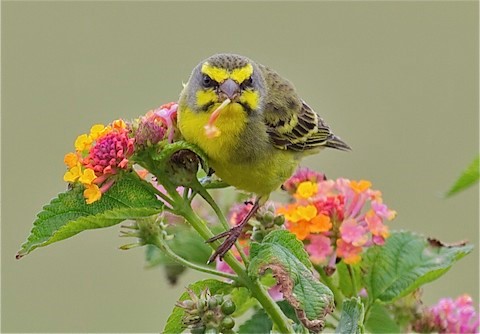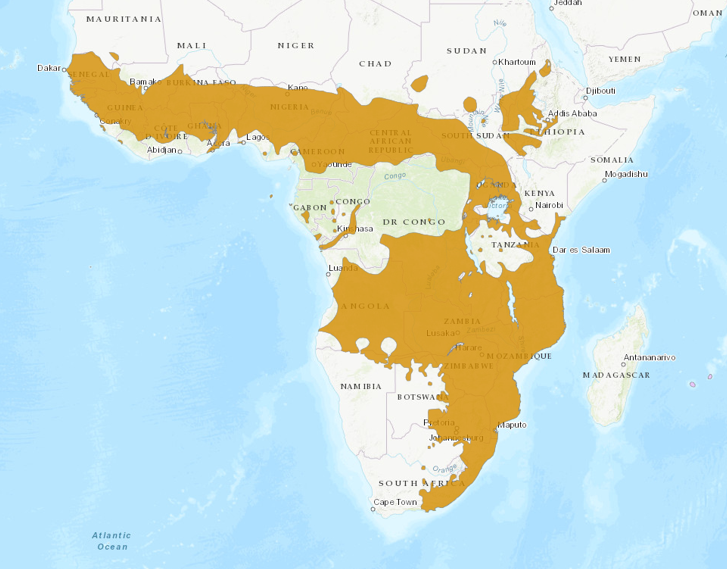Birdfinding.info ⇒ Common across most of its range, especially in eastern Africa from Uganda and Kenya to eastern South Africa, and separately in Gambia and coastal Senegal. In Hawaii it is very common in city parks of Honolulu (e.g., Kapiolani) and nearly throughout the Big Island, especially along the Kona coast. In Singapore, it is most often found at Bishan Park, Lorong Halus, and Gardens by the Bay.
Yellow-fronted Canary
Crithagra mozambica
Sub-Saharan Africa in a wide range of open and wooded habitats, but not in deserts or dense forests.
Widespread from Senegal east to Sudan and Ethiopia and south to southern Angola, northeastern Namibia (the Caprivi Strip), eastern Botswana, and eastern South Africa. Also on São Tomé the Gulf of Guinea.
Introduced populations are well-established in Hawaii (Oahu and the Big Island) and Mauritius, more tenuously in Singapore and Rodrigues, and possibly also in Hong Kong.
Identification
A small, bright-yellow canary with a bold facial pattern. Somewhat variable across its range. Subspecies vary widely, with the most divergent being in East Africa.
The most typical subspecies have all-yellow underparts, mostly olive upperparts, with a yellow rump and a grayish crown and nape, and fine black streaks on the crown.
The face is mostly yellow with a bold black whisker and eyestripe. Above the eyestripe is a broad yellow eyebrow—if viewed frontally, the brows join to form a yellow visor.
The sexes are similar, except that females tend to be plainer and less boldly marked.
In some subspecies—especially grotei of Sudan and Ehtiopia—both sexes are comparatively plain and washed-out.

Yellow-fronted Canary. (South Point, Big Island, Hawaii; July 18, 2018.) © Jordan Roderick
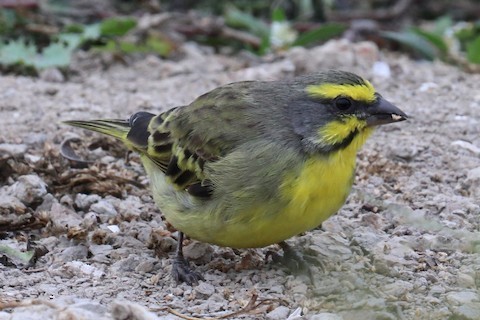
Yellow-fronted Canary, with limited yellow—possibly an immature. (Mai Po, Hong Kong; January 4, 2019.) © Wing Yan Ng

Yellow-fronted Canary. (Kumana Dam, Kruger National Park, South Africa; December 1, 2019.) © Maryse Neukomm

Yellow-fronted Canary, male. (Fort DeRussy Beach Park, Honolulu, Hawaii; February 23, 2019.) © Nate Brown
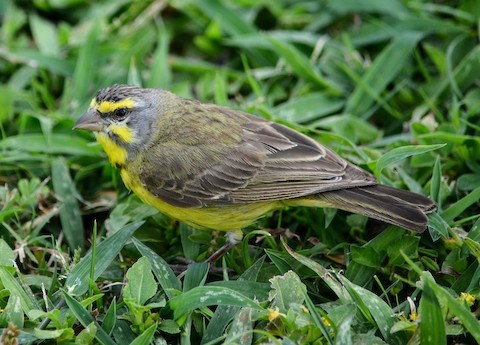
Yellow-fronted Canary, female. (Fort DeRussy Beach Park, Honolulu, Hawaii; February 23, 2019.) © Nate Brown

Yellow-fronted Canary. (Kapiolani Park, Honolulu, Hawaii; July 2, 2008.) © Michael Walther
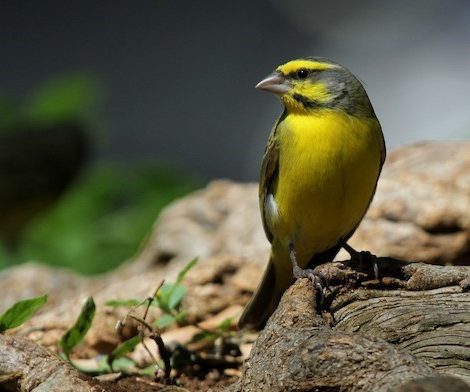
Yellow-fronted Canary. (Kapiolani Park, Honolulu, Hawaii; February 2, 2013.) © Matthew Grube
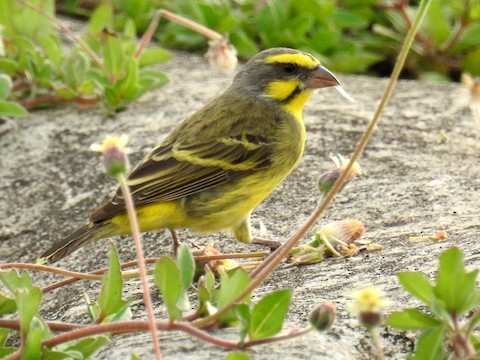
Yellow-fronted Canary. (Gardens by the Bay, Singapore; September 15, 2017.) © Chow Chong Peck

Yellow-fronted Canary. (Kapiolani Park, Honolulu, Hawaii; September 10, 2018.) © Bradley Hacker
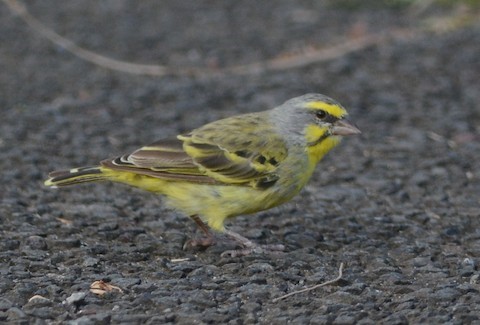
Yellow-fronted Canary, likely an immature moulting into adult plumage. (Laupahoehoe Point County Park, Big Island, Hawaii; December 27, 2018.) © David Roberts
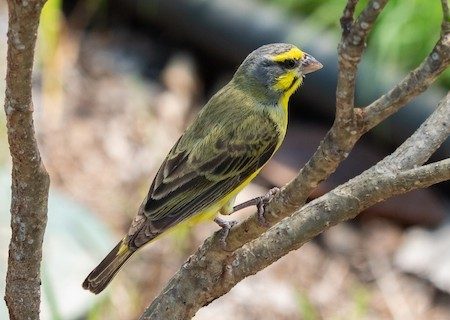
Yellow-fronted Canary, dorsal view. (Kapiolani Park, Honolulu, Hawaii; October 8, 2014.) © Grace Oliver
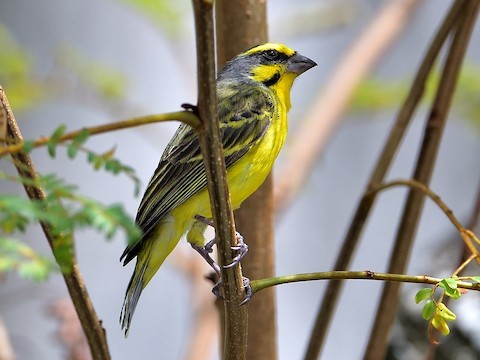
Yellow-fronted Canary. (Bishan Park, Singapore; March 14, 2020.) © Choong YT
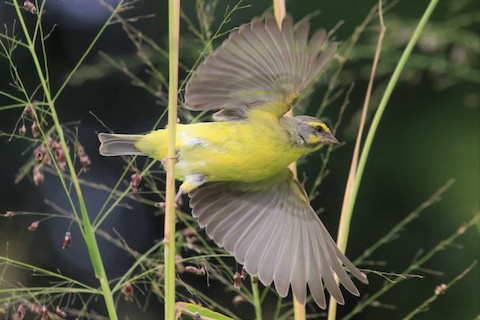
Yellow-fronted Canary. (Pepeekeo, Big Island, Hawaii; August 31, 2020.) © Kent Forward
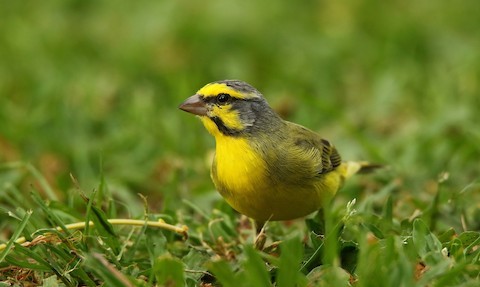
Yellow-fronted Canary. (Kuhio Beach Park, Waikiki, Oahu, Hawaii; July 25, 2017.) © Thanasis Tsafonis
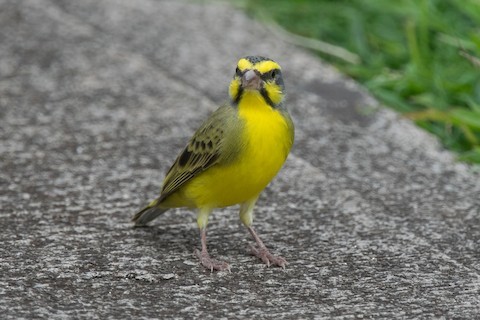
Yellow-fronted Canary. (Kapiolani Park, Honolulu, Hawaii; May 27, 2017.) © Nicole Christensen
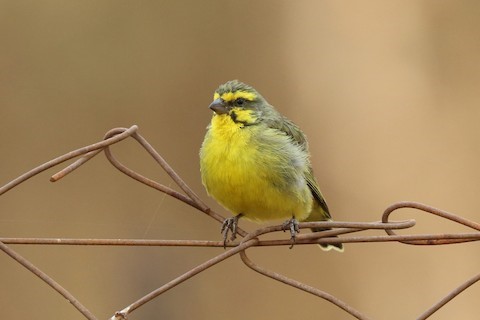
Yellow-fronted Canary. (Frontier Mine, Katanga, Democratic Republic of the Congo; September 22, 2013.) © Nigel Voaden

Yellow-fronted Canary. (Limpopo, South Africa; May 12, 2013.) © Dan Jones
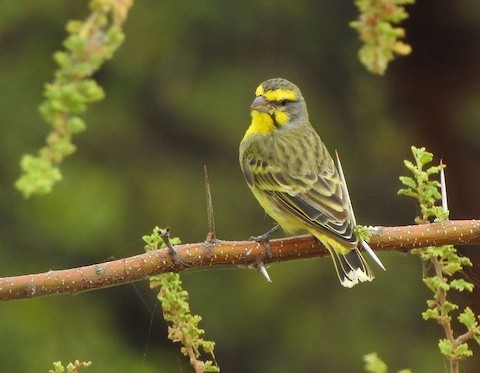
Yellow-fronted Canary, showing white tail-tip. (Nkopola, Malawi; May 24, 2018.) © Ad Konings

Yellow-fronted Canary, showing yellowish tail-tip. (Bishan Ang Mo Kio Park, Singapore; February 7, 2019.) © Steven Cheong
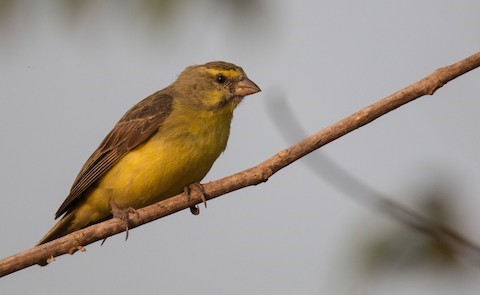
Yellow-fronted Canary, C. m. grotei, showing the dull coloration and blurred markings typical of this subspecies. (Gambela, Ethiopia; December 15, 2014.) © Ian Davies
The most divergent subspecies, barbatus, which occurs across much of eastern Africa from South Sudan and Ethiopia to Tanzania (possibly to Malawi), has an entirely olive, not grayish, crown and nape, and is generally yellower overall. As a result, it is readily confused with Yellow, Brimstone, and Grosbeak Canaries (see below).
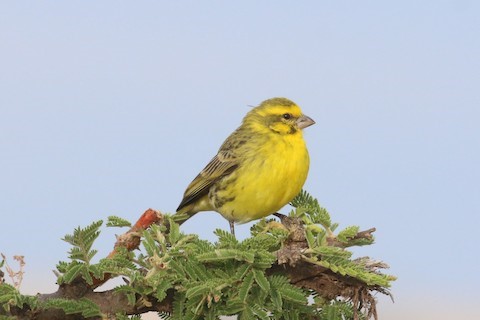
Yellow-fronted Canary, C. m. barbatus, showing essentially all-yellow plumage. (Naboisho Conservancy, Kenya; November 10, 2018.) © Allison Miller
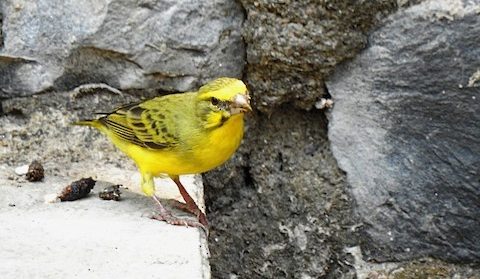
Yellow-fronted Canary, C. m. barbatus, showing essentially all-yellow plumage. (Gambela, Ethiopia; March 24, 2018.) © Joshua Smoulders

Yellow-fronted Canary, C. m. barbatus. (Masindi, Uganda; January 22, 2019.) © Santiago Caballero Carrera

Yellow-fronted Canary, C. m. barbatus, showing olive crown and nape. (Olduvai Gorge, Ngorongoro Conservation Area, Tanzania; July 5, 2019.) © T I

Yellow-fronted Canary, C. m. barbatus, showing essentially all-yellow plumage. (Mbarara, Uganda; May 4, 2019.) © Vincent Wang
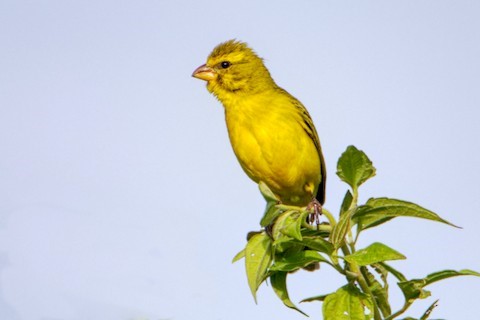
Yellow-fronted Canary, C. m. barbatus, showing essentially all-yellow plumage. (Busia, Kenya; November 28, 2019.) © James Kashangaki
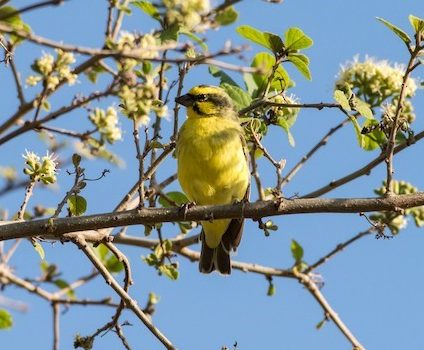
Yellow-fronted Canary, C. m. barbatus. (Sayari Camp, Mara, Tanzania; January 8, 2017.) © Hank Davis
Immatures apparently begin mostly grayish and gain the adult yellow coloration in stages.

Yellow-fronted Canary, immature with all-gray plumage. (Kapiolani Park, Honolulu, Hawaii; December 4, 2016.) © Laura Keene

Yellow-fronted Canary, immature with yellow limited to the throat and center of the chest. (Aimakapa Pond, Big Island, Hawaii; December 5, 2003.) © Etienne Artigau
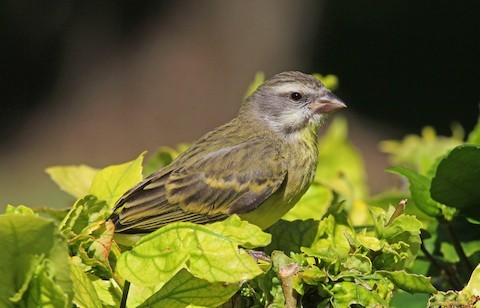
Yellow-fronted Canary, immature moulting into adult plumage. (Black River, Mauritius; June 29, 2017.) © Paul Lewis

Yellow-fronted Canary, immature moulting into adult plumage. (Kruger National Park, South Africa; November 28, 2019.) © Maryse Neukomm

Yellow-fronted Canary, immature with yellow on the face, throat, and chest. (Satara Camp, Kruger National Park, South Africa; September 30, 2018.) © Volker Hesse

Yellow-fronted Canary, immature moulting into adult plumage. (Waikoloa, Big Island, Hawaii; September 4, 2019.) © Michael Bolte

Yellow-fronted Canary, immature moulting into adult plumage. (For DeRussy Beach Park, Honolulu, Hawaii; January 28, 2019.) © David Stekoll
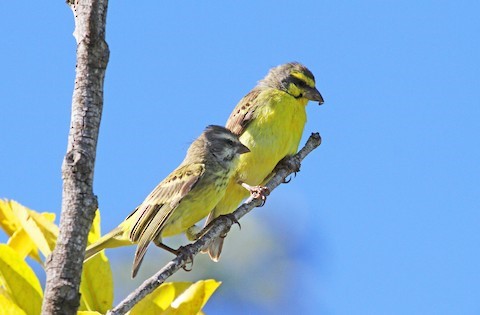
Yellow-fronted Canary, adult and immature. (Black River, Mauritius; June 29, 2017.) © Paul Lewis
Cf. Brimstone and Grosbeak Canaries. Yellow-fronted Canary overlaps widely with both Brimstone and Grosbeak Canaries across eastern and southern Africa. Typical Yellow-fronted is easily distinguished by its bold facial pattern and gray crown and nape, but the subspecies barbatus of eastern Africa is very similar to Brimstone and Grosbeak in pattern and coloration.
The biggest difference between barbatus and Brimstone and Grosbeak Canaries is size: barbatus is smaller and has a proportionately shorter tail and smaller bill. Brimstone and Grosbeak are also yellower overall and have weaker facial patterns, but these differences are matters of degree, variable within each species, difficult to judge in the field, and often unreliable.
Cf. Yellow Canary. Yellow and Yellow-fronted Canaries overlap marginally from eastern Namibia to eastern South Africa, and possibly elsewhere due to introductions. The subspecies of Yellow-fronted that naturally occur alongside Yellow are readily distinguished by their gray crown and nape, and usually by their bolder facial patterns. Also, female Yellow is entirely different—plain and streaky—so pairs or flocks are usually easy to distinguish.
However, the subspecies barbatus of eastern Africa is very similar to male Yellow in pattern and coloration, and could be very difficult to distinguish if they were to occur together. Male Yellow is more intensely yellow overall and has a weaker facial pattern than barbatus, but these differences are matters of degree, variable within each species, difficult to judge in the field, and often unreliable.
Notes
Polytypic species consisting of ten recognized subspecies.
References
BirdLife International. 2018. Crithagra mozambica. The IUCN Red List of Threatened Species 2018: e.T22720181A131998999. https://dx.doi.org/10.2305/IUCN.UK.2018-2.RLTS.T22720181A131998999.en. (Accessed May 6, 2020.)
Clement, P. 2020. Yellow-fronted Canary (Crithagra mozambica). In Handbook of the Birds of the World Alive (J. del Hoyo, A. Elliott, J. Sargatal, D.A. Christie, and E. de Juana, eds.). Lynx Edicions, Barcelona. https://www.hbw.com/node/61308. (Accessed May 6, 2020.)
Clement, P., A. Harris, and J. Davis. 1993. Finches and Sparrows: An Identification Guide. Princeton University Press, Princeton, N.J.
eBird. 2020. eBird: An online database of bird distribution and abundance. Cornell Lab of Ornithology, Ithaca, N.Y. http://www.ebird.org. (Accessed May 6, 2020.)
Pyle, R.L., and P. Pyle. 2017. The Birds of the Hawaiian Islands: Occurrence, History, Distribution, and Status. Version 2 (January 1, 2017). http://hbs.bishopmuseum.org/birds/rlp-monograph/. B.P. Bishop Museum, Honolulu, Hawaii.
Sinclair, I., P. Hockey, W. Tarboton, and P. Ryan. 2011. Birds of Southern Africa (Fourth Edition). Random House Struik (Pty) Ltd. Cape Town, South Africa.
van Perlo, B. 2002. Birds of Western and Central Africa. Princeton University Press, Princeton, N.J.
Xeno-Canto. 2020. Yellow-fronted Canary – Crithagra mozambica. https://www.xeno-canto.org/species/Crithagra-mozambica. (Accessed May 5, 2020.)
